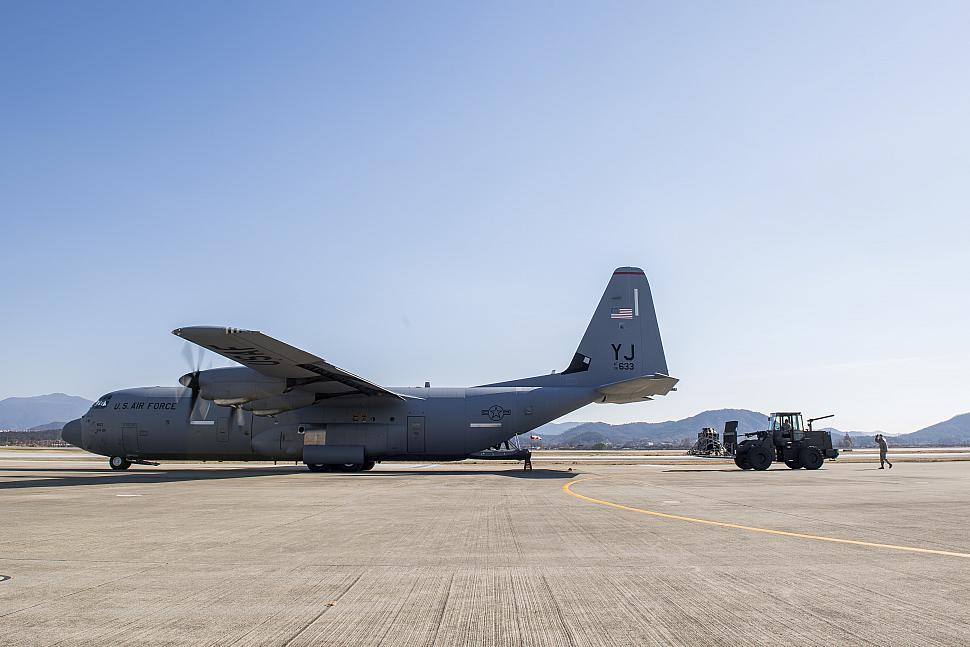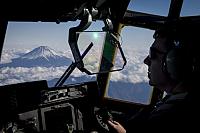C-130 News
C-130 Hercules News
PACAF and AMC Provide Airlift for Vigilant Ace 18
December 6, 2017 (by
SrA Donald Hudson) -
In preparation for exercise Vigilant Ace 18, three U.S. Air Force Bases: Yokota Air Base, Japan, Dyess AFB, TX, and Little Rock AFB, AR, came together to provide airlift support for the annual exercise, Vigilant Ace 18.

Vigilant Ace 18, is a large scale annual exercise between the US and the Republic of Korea aimed at providing realistic air combat training to test and refine readiness and interoperability between the two partnering forces. The exercise also helps to build on the strong relationship between the two allies and demonstrates the commitment and resolve of the US to the region's stability.
Due to Yokota transitioning from the C-130H Hercules to the C-130J Super Hercules, Dyess and Little Rock AFB each sent a C-130J with support crews to assist the 374th Operations Group with this year's bilateral exercise.
"Not only are the aircrews from the other bases helping the 374 OG maximize its participation while halfway through its J-model transition," said Col Mark Mullarkey, 374 OG commander. "But they are also building their own experience to carry home by training with us in a simulated high-end, contested environment to include demonstrating their ability to survive & operate C-130J aircraft in a chemical environment."
The support the Air Mobility Command has given the Pacific Air Forces during the exercise was needed to help offset the work load on Yokota's aircrews during the exercise's increased operations tempo. In one day of pre-exercise preparation, the 374 OG organized 13 missions with 39 sorties and more to come as the exercise continues.
"Those two extra tails are the insurance plan we needed," said Mullarkey. "The additional crews will help us push crew turn times from 14-15 hours to 21 hours, and ease the circadian rhythm shifts on the aircrews."
The goal of military exercises is to make the simulated missions as real as possible while keeping a safe environment for the participants. To ensure safe flying, the USAF aircrews are required to take a "crew rest," between flights. While this can limit operations tempo it greatly reduces the risk of airborne incidents by allowing aircrew personnel time to sleep and decompress between missions.
While Dyess and Little Rock AFB came to assist Yokota, they will also take back with them knowledge and experience from participating in the chemical, biological, radiological and nuclear portion of the exercise.
"Yokota does a lot more CBRN training then we traditionally do in the states," said Capt. Kyle Schneider, 40th Airlift Squadron C-130J pilot. "So we are going to take any tips in the process Yokota follows and bring that information back to integrate with our future exercises."

Airmen unload cargo from C-130J #06-4633 from 36 AS in preparation for exercise Vigilant Ace 18 on December 1, 2017, at Gwangju Airbase, Republic of Korea. [USAF photo by SrA Donald Hudson]
Due to Yokota transitioning from the C-130H Hercules to the C-130J Super Hercules, Dyess and Little Rock AFB each sent a C-130J with support crews to assist the 374th Operations Group with this year's bilateral exercise.
"Not only are the aircrews from the other bases helping the 374 OG maximize its participation while halfway through its J-model transition," said Col Mark Mullarkey, 374 OG commander. "But they are also building their own experience to carry home by training with us in a simulated high-end, contested environment to include demonstrating their ability to survive & operate C-130J aircraft in a chemical environment."
The support the Air Mobility Command has given the Pacific Air Forces during the exercise was needed to help offset the work load on Yokota's aircrews during the exercise's increased operations tempo. In one day of pre-exercise preparation, the 374 OG organized 13 missions with 39 sorties and more to come as the exercise continues.
"Those two extra tails are the insurance plan we needed," said Mullarkey. "The additional crews will help us push crew turn times from 14-15 hours to 21 hours, and ease the circadian rhythm shifts on the aircrews."
The goal of military exercises is to make the simulated missions as real as possible while keeping a safe environment for the participants. To ensure safe flying, the USAF aircrews are required to take a "crew rest," between flights. While this can limit operations tempo it greatly reduces the risk of airborne incidents by allowing aircrew personnel time to sleep and decompress between missions.
While Dyess and Little Rock AFB came to assist Yokota, they will also take back with them knowledge and experience from participating in the chemical, biological, radiological and nuclear portion of the exercise.
"Yokota does a lot more CBRN training then we traditionally do in the states," said Capt. Kyle Schneider, 40th Airlift Squadron C-130J pilot. "So we are going to take any tips in the process Yokota follows and bring that information back to integrate with our future exercises."
Courtesy of 374th Airlift Wing/Public Affairs
Related articles:
Forum discussion:
Tags
Forum discussion:
- Start a discussion about this article in the C-130.net forum.
Tags
Additional images:

